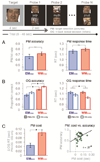Neural evidence of the strategic choice between working memory and episodic memory in prospective remembering
- PMID: 27845034
- PMCID: PMC5148635
- DOI: 10.1016/j.neuropsychologia.2016.11.006
Neural evidence of the strategic choice between working memory and episodic memory in prospective remembering
Abstract
Theories of prospective memory (PM) posit that it can be subserved either by working memory (WM) or episodic memory (EM). Testing and refining these multiprocess theories of PM requires a way of tracking participants' reliance on WM versus EM. Here we use multi-voxel pattern analysis (MVPA) to derive a trial-by-trial measure of WM use in prospective memory. We manipulated strategy demands by varying the degree of proactive interference (which impairs EM) and the memory load required to perform the secondary task (which impairs WM). For the condition in which participants were pushed to rely more on WM, our MVPA measures showed 1) greater WM use and 2) a trial-by-trial correlation between WM use and PM behavior. Finally, we also showed that MVPA measures of WM use are not redundant with other behavioral measures: in the condition in which participants were pushed more to rely on WM, using neural and behavioral measures together led to better prediction of PM accuracy than either measure on its own.
Keywords: Episodic memory; MVPA; Prospective memory; Working memory; fMRI.
Copyright © 2016 The Authors. Published by Elsevier Ltd.. All rights reserved.
Conflict of interest statement
None
Figures



References
-
- Barban F, Carlesimo GA, Macaluso E, Caltagirone C, Costa A. Functional interplay between stimulus-oriented and stimulus-independent attending during a prospective memory task. Neuropsychologia. 2014;53:203–212. - PubMed
-
- Beck SM, Ruge H, Walser M, Goschke T. The functional neuroanatomy of spontaneous retrieval and strategic monitoring of delayed intentions. Neuropsychologia. 2014;52:37–50. - PubMed
-
- Braver TS, Reynolds JR, Donaldson DI. Neural mechanisms of transient and sustained cognitive control during task switching. Neuron. 2003;39:713–726. - PubMed
-
- Burgess PW, Gonen-Yaacovi G, Volle E. Functional neuroimaging studies of prospective memory: what have we learnt so far? Neuropsychologia. 2011;49:2246–2257. - PubMed
MeSH terms
Grants and funding
LinkOut - more resources
Full Text Sources
Other Literature Sources

